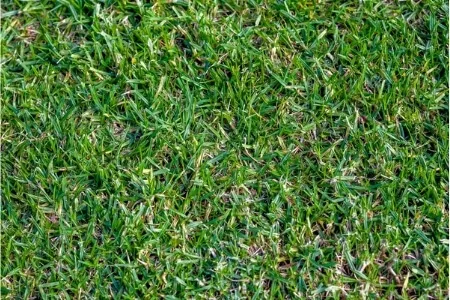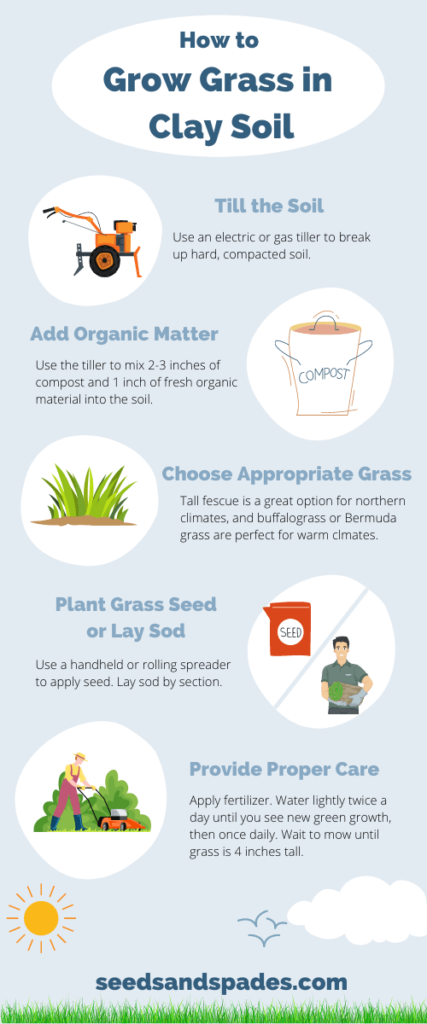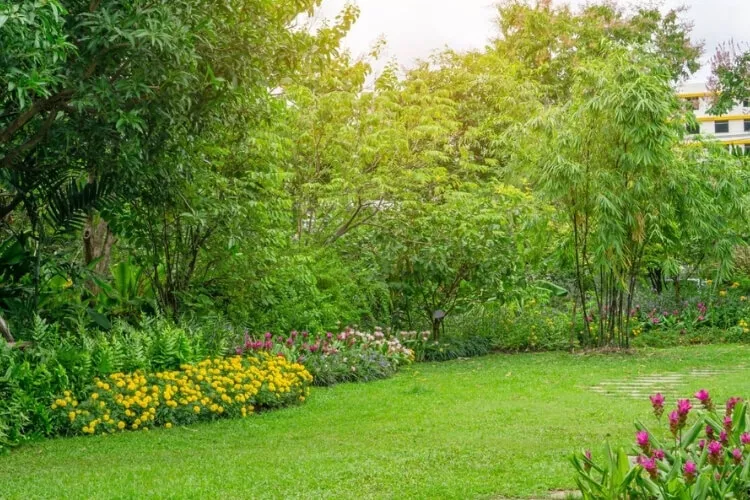We all dream of a lush green yard, don’t we? But most of us have to put in the work to create the yard of our dreams. It is rare that the soil you have is already perfect for growing grass.
Does your soil have a thick, clayey consistency? Maybe you’re feeling discouraged in your pursuit of healthy, vibrant grass. Take heart- it’s entirely possible to have a thriving yard in clay soil.
To successfully grow grass in clay soil, start by breaking up the tough soil with a tiller. Apply a 2-3 inch layer of compost mixed with 1 inch of fresh organic material (shredded leaves, grass clippings, etc) and till it into the soil. Allow the soil to rest for a few weeks to give the organic amendments a chance to break down. Then apply grass seed or sod that’s appropriate for your regional climate and follow a care protocol to get your new grass off to a good start in your clay soil.
In this article, we’ll lay out the basics of how to prepare your yard and recommendations for the best grass to grow in clay soil. We’ll also cover proper care tips for keeping your new grass heathy.
Table of Contents
Why is it Hard to Grow Grass in Clay Soil?
Soil comes in three main consistencies:
- Clay
- Sand
- Silt
Of these, clay has the smallest particles, according to the Utah State University Forestry Extension. This small particle size gives clay the ability to hold nutrients and water extremely well. Sounds great, right?
Unfortunately, this trait that can actually lead to some issues:
- Clay soil can compact easily, holding way too much water and drowning plant roots.
- Clay can get hard, dry, and cracked, so when it’s too dry, it feels like concrete.
- When clay is too wet, it can get sticky and messy.
None of these qualities match our vision for a dreamy, vibrant lawn!
As is, clay soil will not grow grass on its own. Instead, it has to be amended (garden vocab!!), which means you have to add to the soil to change its physical composition.
How to Tell if You Have Clay Soil
First, you should know that the clay-ness of your soil can vary. It is pretty unlikely that your soil is 100% clay. There are a couple of ways to know whether you’re dealing with clay soil:
- Soil color. Instead of a rich, dark brown, clay soil has a reddish/orange hue that somewhat resembles rust.
- Standing water. if your lawn has standing pools of water hours after a rainfall, you can be pretty sure that dense clay is preventing the water draining away.
To test how dense your clay soil is, you can administer a ribbon test:
- Gather a small handful of your soil and moisten it. With your fingers, roll it into a little ball.
- Squish your soil ball between your thumb and index finger, so now you have a flat ribbon-shaped bit of soil.
- If your ribbon is long—around two inches—your soil has dense, heavy clay content. If your ribbon is short—an inch or less—its clay content is smaller.
For a helpful visual, check out this descriptive chart to assess your soil type via the ribbon test.
Throughout the process of amending your soil, you can continue to come back to the ribbon test to see how your soil density is changing.
If your ribbon is shorter than it was when you initially tested the soil, congratulations! Your soil amendment is working.
Will Grass Grow In Clay Soil?
Yes, you can absolutely have a beautiful, thriving lawn even if your soil contains a heavy clay element. The key is preparing your soil appropriately and choosing a grass type that can stand up to clay and is appropriate for your regional climate.
Troy Hinke of Urban Worm Company has plenty of experience working with dense clay soil from his time living and working in Tennessee. “Most turf grasses on the market come in two categories: warm-season grasses and cool-season grasses,” he says. “Warm-season grasses do best in the southern United States while cool-season grasses generally do better in the upper half of the U.S.”
Tall Fescue

Tall fescue is heat-, drought-, and cold-tolerant. It can handle chilly weather and frequent shade, so it does well in Northern and Midwest states.
Tall fescue thrives in mild-weather months, and it is best to plant in spring or early fall, when temperatures are between 50 and 65 degrees Fahrenheit.
Bermuda Grass

Both heat- and drought-tolerant, Bermuda grass can handle hot summers, while also repair quickly enough to withstand heavy foot traffic.
Bermuda grass likes warmth and sunshine and thrives in Southern states (from east to west coast). In warm regions, Bermuda grass is a popular choice for sports fields which require durability. It is best to plant in early summer, when temperatures are consistently between 70 and 85 degrees Fahrenheit.
Buffalo Grass

Heat- and drought-tolerant, buffalo grass hails from the prairie lands of the Great Plains region. It is hardy and low-maintenance, growing thick and requiring little mowing.
It is a perennial, warm-season grass that requires a lot of sun but not much water. It is best planted in early summer when temperatures stay between 70 and 85 degrees Fahrenheit.
RELATED: For more details on how fast you can expect to see results from your new grass, stop by our post looking at grass seed growth rates.
Besides the typical grass lawn option, Troy offers another interesting suggestion:
“Check out low-maintenance alternative lawns. A crimson clover lawn can add beauty as well as adding nitrogen to the soil. A wildflower lawn is gorgeous to see as well as smell, and it helps to feed pollinator insects.
Troy continues, “There are other lawn seed mixes that include plants other than your run-of-the-mill monoculture lawn seeds. Lawn mixes that are aimed to allow for no mowing, low-maintenance, and even some that help to feed a backyard flock of chickens.”
Many of these ground cover plants, like clover, form strong, dense root networks that can effectively break up clay soil naturally. And alternative lawns also tend to be more drought-resistant, so they remain beautiful even during a dry summer.
It’s definitely a step out of the ordinary, but going the grass-less route for your clay soil might be worth considering!
How to Improve Clay Soil for Lawns
Now that you’ve decided on the type of grass you want, how do you actually amend your soil to prepare it for growing grass?
The key is organic material.
Organic materials are natural plant and animal products which are in the process of decay. This includes:
- Compost
- Grass clippings
- Dead leaves
- Manure
- Organic fertilizers
Adding organic material into your clay soil improves its ability to drain water, and it adds nutrients into the ground.
These nutrients stimulate the microorganisms and bugs that live in the earth. Healthy microorganisms do amazing things, like feeding on harmful microbes and releasing nutrients into the soil when they die.
This consequently creates healthier conditions for plant roots, leading to more vivacious plant life in your yard.
Should You Till Clay Soil?
It’s easy to see that organic materials can make a big difference in transforming your clay soil into a hospitable home for grass. But how do you do it?
You could just apply your organic materials on top of your yard and wait for it to incorporate into the existing soil. This will take a while, but it will save you from disrupting the organic matter already benefiting your soil—which is better over the long term.
On the other hand, many people prefer to expedite the process of dispersing organic matter into the soil with a tiller. And this is exactly the process that Lawnmower Larry, retired professional landscaper and founder of Lawnmower Larry, advises.
“Your goal here is to turn the top 6 inches of your clay soil and mix in some secret ingredients to create the perfect foundation for your garden. This aerates your soil, loosens it, and conditions it for your new lawn.”
Here’s Larry’s personal clay soil rescue blend:
- 6 inches of your existing clay soil, not too wet, not too dry, just slightly moist
- 2-3 inches of a quality compost
- 1 inch of other organic matter such as grass clippings, leaf litter, organic mulch, manure or a combination of several
- For acidic soil: lime or a low-iron rock dust blend
- For alkaline soil: a sprinkling of gypsum
if possible, let your tilled soil sit and breathe for at least a couple of weeks before seeding it. As the organic materials incorporate, the clay soil will become lighter and less compacted. This creates space for a deeper root system, and it also makes water and nutrients more available to plants.
Though amending your soil takes time, it brings health and life to your yard, and creates a space where grass and plants can flourish!
RELATED: Check out some great tiller options in our post on the best tillers to choose for breaking new ground!
Planting Grass in Clay Soil
Once you’ve amended your soil and chosen the grass you want, you’re ready to start planting.
Don’t feel like this means you need to call in the landscapers! You can choose to sod or seed on your own.
So what’s the difference between sod and seed? Here are the details on both methods, and the pros and cons of each.
Should You Use Grass Sod on Clay Soil?
Sod is pre-grown, established grass that you can simply install over prepared soil. It’s basically an instant lawn!
If you choose to sod, you will receive your grass in a roll to unfold on your lawn. Sod may also be available as small blocks, which can be ideal if you’re working with a small area.
Pros of Using Sod:
- Offers fast results for a thick, full lawn
- Excellent at blocking weeds
Cons of Using Sod:
- Higher cost upfront
- Can damage the grass’s root system if improperly installed
Should You Use Grass Seed on Clay Soil?
As the traditional method for establishing your lawn, high-quality grass seed is readily available at reasonable prices.
If you choose to seed, you can hand seed a small patch of land without a problem—just sprinkle the grass seeds over the area you want to grow. If your lawn is sizable, use a seeder you can roll across the yard.
Pros of Using Grass Seed:
- Cheaper from the outset
- Easy to install on your own- even if you’re a novice!
Cons of Using Grass Seed:
- Allow at least one full season for seed to fill in
- Weeds are more likely to break through
How Much Grass Seed Will You Need?
Check out this grass seed calculator to determine how much seed you’ll need.
Caring for Grass in Clay Soil
Now that you’ve got your seed or sod applied, let’s look at what you can do to get your lawn established and healthy for the long term.
Aerating
Since clay is naturally dense, it doesn’t allow for many air pockets to form in the soil. Plants absorb oxygen through through roots, and air in the soil also helps keep the soil from staying dangerously wet.
The solution is aerating. Aerating is the process of introducing more air flow into your soil, either by mechanical or chemical means:
- Mechanical aerators remove plugs of soil, leaving small holes in your lawn that let air and organic material penetrate the deeper levels.
- Liquid aerators use chemicals to break down soil compactions and produce a looser texture.
Lawnmower Larry recommends making aeration a part of your routine lawn maintenance. “Once your lawn is established, aerate your soil at least annually. It’s probably best to do it mechanically the first time, but you should be okay to use liquid aeration after that.”
Many lawn services offer aeration as part of lawn care options. If you’d prefer to go the DIY route, this core aerator from Yard Butler produces consistent results. For a liquid aerator, this formula from LawnStar is a great option to consider (bonus-it’s an American-made product!)
Fertilizing
You can choose to fertilize your lawn before or after you seed—either way is fine! Once both are in the ground, just run a rake over the surface of your lawn to mix the seed and fertilizer together.
Note that clay soils already hold a lot of nutrients, so they don’t require as much extra fertilization as other soil types. Regardless, fertilizer is still a welcome addition to clay-soil growing and can/should be used throughout the year.
- A formula with a high phosphorous, like The Andersons Premium New Lawn Starter, is helpful for establishing healthy root systems in new lawns.
- When your lawn is more mature, you want a higher nitrogen content to maintain a lovely green color, like Pennington Ultragreen Lawn Fertilizer.
- A balanced formula, like a 13-13-13 blend, provides equal amounts of all three macronutrients, and is usually shows results quickly.
And even something as simple as keeping a compost pile (a mixture of organic food scraps, yard waste, paper scraps, etc.) in your yard can also benefit the overall health of your soil—and thus nourish your grass, trees, and plants.
Watering
When it comes to watering your new grass, remember that clay soil holds a lot of water. Giving too much water at once could wash your new seed away or drown the roots.
Give smaller drinks on a more frequent basis, and allow the water to fully soak into the soil. Water your grass lightly a couple of times a day until you see green appearing, then reduce your watering to once a day, giving a little more water at a time.
Mowing
Don’t mow your new grass until it’s at least 4 inches tall. When grass is shorter than this, the root systems aren’t developed enough to anchor your grass in the ground against the lawnmower’s suction, and you could uproot all the grass seedlings you’ve worked so hard to achieve. It’s worth waiting!
Also, look into the ideal mowing height for your particular kind of grass. Mowing your grass tall will shade your soil to keep it cool and prevent it from drying out. This can really benefit your soil’s health, but some grasses (Bermuda grass, for example) can be kept short, at just over an inch tall.

Frequently Asked Questions about Growing Grass in Clay Soil
Key Takeaways
- Clay soil is made up of small particles, which give it its dense texture. Clay soil tends to be high in mineral content, and it is usually more acidic.
- You can find out if you have clay soil by looking at the overall color (it will be reddish), how the soil behaves when you work with it in your hands and how long standing water remains after a rainfall.
- If you are growing in clay soil, amending the soil with organic material to create a more breathable consistency will benefit the health of your root systems.
- Pick a grass that grows well in clay and in your climate region. Tall fescue and buffalo are two good choices.
- Once your new grass is planted, be patient to allow it to fill out your yard.
- Take good care of it by adding fertilizer, watering appropriately and mowing it at the appropriate height.
Final Thoughts
The lawn of your dreams is absolutely within your reach, but you have to be willing to put in the work and the time. Your reward will be a beautiful green space where you will be happy to play, eat, and gather with those you love!
Have you ever tried to grow grass in clay soil? What was your experience like? Do you have any helpful tips to share, or do you have any questions?
We’d love to hear from you in the comments!

